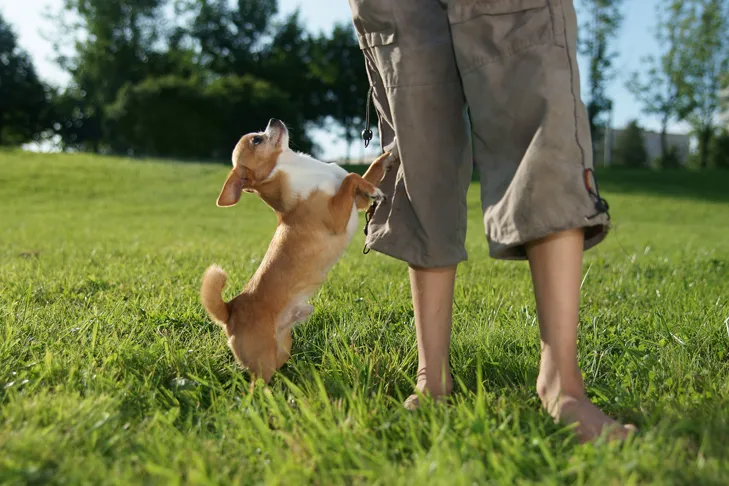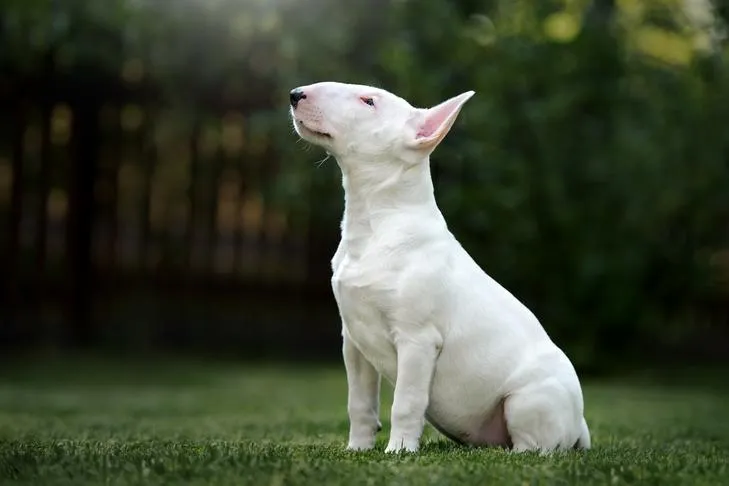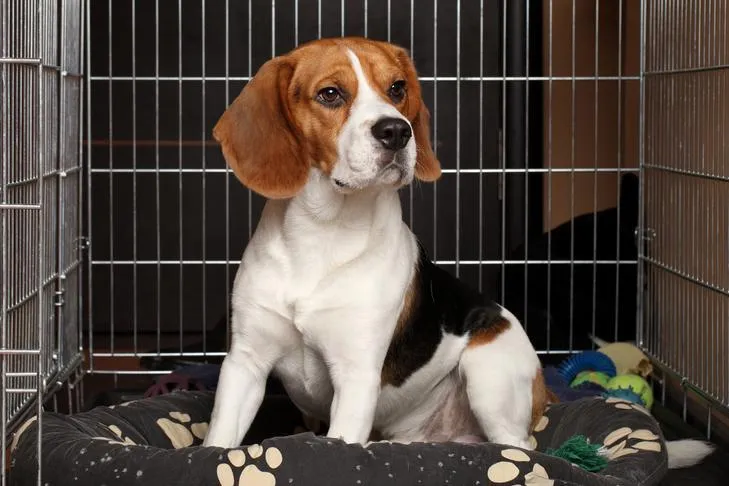Jumping up is a natural behavior for dogs, a way to greet others face-to-face and ensure they get attention. While it’s instinctual, it can be inconvenient and even hazardous from a human perspective, potentially soiling clothes or knocking over individuals, especially children and the elderly. Teaching your dog a more polite and secure way to greet people is essential. This guide will help you understand why dogs jump and provide practical, effective training methods to curb this habit.
Understanding the root cause of jumping behavior is the first step in addressing it. Dogs often repeat actions that result in rewards, and for many, human attention is a significant reward. This attention can come in various forms, including direct interaction, praise, or even negative reactions like yelling or pushing them away. From a dog’s perspective, these interactions can feel like a game. To successfully eliminate jumping, it’s crucial to remove these associated rewards and teach your dog an alternative, acceptable way to greet people.
 A small dog jumping up to greet someone
A small dog jumping up to greet someone
The Psychology Behind a Dog’s Greeting Jump
The tendency for dogs to jump when greeting stems from their natural social instincts. In a pack setting, dogs often greet each other with a raised muzzle, which can translate to jumping in their interactions with humans. More importantly, jumping reliably gets them closer to a person’s face, which is where they would naturally interact with other dogs. The immediate positive reinforcement of receiving attention, even if it’s just being pushed away, solidifies the behavior. Therefore, the key to modifying this behavior lies in removing the perceived reward and offering a more desirable alternative.
When a dog jumps, they are seeking connection and attention. If they receive any form of acknowledgment – be it a pet, a verbal reprimand, or even just a stare – their jumping behavior is reinforced. This is why ignoring the jump might not be sufficient on its own; it needs to be paired with teaching a specific, desired behavior. Your goal is to show your dog that a different, more acceptable action leads to the positive interaction they crave.
Training Alternative Greeting Behaviors
While ignoring jumping can theoretically lead to its cessation because the reward is removed, this approach is often impractical in real-world scenarios. Not everyone you encounter will be aware of or willing to participate in ignoring your dog’s jumping. Furthermore, this can lead to frustration for your dog. Instead, it’s more effective to teach them what you want them to do.
You can decide what an appropriate greeting looks like for your dog. Whether it’s simply keeping all four paws on the floor, offering a polite sit, or even a down, the important aspect is to provide a clear alternative. Teaching your dog to “sit” for greetings, for instance, is much easier for them to understand than being told “don’t jump.” This positive redirection is the cornerstone of effective dog training.
How to Train “Four on the Floor”
This method focuses on rewarding your dog for keeping all four paws on the ground during greetings. The core idea is to preemptively reward the desired behavior, making it more appealing than jumping.
- Leashed Introduction: Have a helper approach your dog while your dog is on a leash. This provides control and prevents them from practicing the jumping behavior.
- Treat Placement: Just before the person reaches your dog, toss several high-value treats onto the floor.
- Greet While Eating: As your dog is occupied with the treats on the floor, have the person calmly pet and greet them.
- End the Greeting: Before your dog finishes the treats, have the person step back, ending the interaction temporarily.
- Repetition and Extension: Repeat these steps. Gradually, as your dog becomes more accustomed to the routine, extend the duration of the greeting, continuing to toss treats on the floor throughout.
- Reward for Grounded Paws: Once your dog reliably keeps all four feet on the ground, allow them to be greeted before you toss the first treat.
- Fade Treats: As your dog understands the connection between staying grounded and receiving attention, gradually reduce the number of treats. Eventually, the greeting itself, along with praise, becomes the primary reward.
The success of this technique hinges on your speed and anticipation. You must be quick to provide the treats before your dog has a chance to jump. If they do jump, the person should immediately turn and walk away, and you should stop dispensing treats. This teaches your dog that jumping results in the cessation of attention, while keeping all paws on the floor leads to positive interaction and rewards. For more on managing puppy behaviors, consider training your puppy not to jump up.
 A Bull Terrier puppy sitting attentively in a yard
A Bull Terrier puppy sitting attentively in a yard
Teaching Your Dog to “Sit” for Greetings
Another highly effective and polite greeting behavior is teaching your dog to sit when meeting people. This method reinforces that a calm, seated posture leads to positive attention.
- Secure Leash: Tether your dog’s leash to a secure object, like a doorknob or a sturdy piece of furniture. This allows you to manage their movement.
- Initiate the Sit: From a few feet away, ask your dog to “sit.” If they comply, calmly approach them.
- Positive Reinforcement for Sitting: If your dog remains seated, offer quiet praise and gentle petting. Continue the greeting as long as they stay in a sit.
- Withdrawal of Attention: The moment your dog stands up, turn and walk away, ending the greeting. This clearly communicates that sitting is what earns them attention.
- Gradual Escalation: As your dog masters sitting for greetings with you, progressively make your approaches more animated and exciting.
- Involve Others: Once your dog reliably sits for you, start practicing with friends and family members, following the same steps.
The more your dog practices sitting, the more natural it will become. Ensuring your dog has a solid “sit” command in other contexts, such as before meals or going outside, will make training sit for greetings much smoother. This foundational command is a crucial part of train your dog like a service dog, demonstrating control and responsiveness.
 A Beagle sitting calmly in its open crate
A Beagle sitting calmly in its open crate
Preventing Jumping While You Train
During the training process, it’s vital to manage your dog’s environment and behavior to prevent them from practicing the unwanted jumping. This “management” phase is crucial for success.
If your dog knows a “go to your place” cue, utilize it whenever the doorbell rings. You can send them to their mat or crate to keep them occupied and away from visitors. Alternatively, placing a dog gate at your entrance can physically prevent them from reaching guests. Keeping your dog on a leash when visitors arrive is another effective management strategy.
Keeping engaging toys and high-value treats near the front door can be a lifesaver. You can toss a toy or treat away from the door to divert your dog’s attention as your guest enters. Your guest can also participate by offering a toy or treat as a reward for your dog’s appropriate greeting. For more on specific scenarios, learn how to teach my dog to stop jumping on guests.
Managing jumping during walks presents a unique challenge, as strangers may not be aware of or adhere to your training rules. Until your dog has mastered polite greetings with familiar people, try to avoid having them greet strangers. Instead, use a “watch me” cue to get your dog’s attention or use a squeaky toy to distract them as the stranger passes by. When you’re ready to practice greetings with people on the street, clearly communicate your dog’s training protocol to bystanders and ask them to ignore your dog if they don’t follow the rules. This consistency will soon help your dog understand how to greet politely, whether at home or out and about. Understanding these principles can also help with related issues, such as how to stop your puppy jumping on the sofa.
Conclusion
Teaching your dog not to jump on people is an achievable goal that requires patience, consistency, and understanding. By identifying the reasons behind the behavior and implementing positive training methods, you can foster a more polite and enjoyable relationship with your dog. Focus on rewarding the desired behaviors, such as keeping all four paws on the floor or sitting, and manage their environment to prevent opportunities for jumping. With consistent effort, your dog will learn to greet everyone with appropriate manners. If you are struggling with your dog’s jumping behavior or other training challenges, consider reaching out to a professional dog trainer for personalized guidance. Remember, a well-trained dog is a happier dog, and a well-behaved dog makes for a more harmonious household. For further advice on keeping your dog from jumping on people, explore how can I keep my dog from jumping on people.
References
- The American Kennel Club (AKC) – Training Rewards
- The American Kennel Club (AKC) – Attention-Seeking Behaviors in Dogs
- The American Kennel Club (AKC) – Are They Playing or Fighting?
- The American Kennel Club (AKC) – Training Treats
- The American Kennel Club (AKC) – Choosing the Right Dog Leash
- The American Kennel Club (AKC) – Teach Your Puppy These 5 Basic Commands
- The American Kennel Club (AKC) – How to Teach Your Dog to Sit
- The American Kennel Club (AKC) – Training Dogs to Ignore Distractions
- The American Kennel Club (AKC) – Teaching “Go to Your Place”
- The American Kennel Club (AKC) – Why Crate Training Is Great for Your Dog
- The American Kennel Club (AKC) – Dog Gates
- The American Kennel Club (AKC) – Best Dog Toys
- The American Kennel Club (AKC) – “Watch Me” Command: Grab Dog’s Attention
